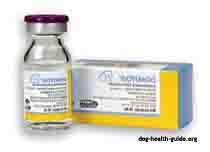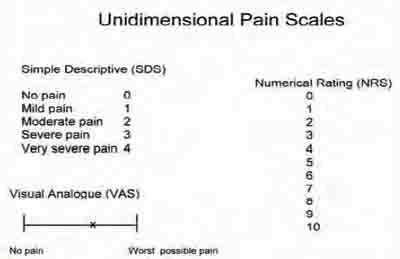Table of Contents
Overview | Types | NSAIDs | Opioids | Alpha-2 Agonists | Stem Cell Therapy
Topicals | Anesthetic | Alternatives | Remedies | Diet | Vet Questions
Summary:
"The selection of a a dog pain killer is based on the intensity of pain, purpose (pre-operative, long term care) and underlying cause. Dog pain meds can take the form of a NSAID, Steroids, Opioids, Alpha-2 Inhibitors, or natural remedies. Options include oral, topical or analgesics administered directly into the body. Pain in dogs can also be managed with alternative approaches such as chiropractic care, massage, herbal remedies and dietary change.
Some experimentation may be required until the most effective dog pain med is identified. Patients will be monitored for response to treatment while trying to find the medicaiton available in the lowest dose, fewest side effects and best outcome. Dogs are carefully monitored for kidney, liver and gastrointestinal problems. When medical treatment is not effective, other options such as surgery are considered. Never give your dog any drug unless it is with the advice of a veterinarian."
Overview
The use of dog analgesics before surgery or for pain management
can reduce the long term impact of pain and the degree of pain. If a
dog is recovering from surgery, pain usually subsides as the dog heals.
Stronger dog pain medications such as opioids are often used for 12 to
24 hours after surgery. NSAIDs are most effective when administered
after surgery and are for longer term use.
Before prescribing any medication, your veterinarian will evaluate the patients behavior, liver function and kidney function. You should also know the potential side effects so you can monitor your dog. Typical side effects are stomach problems such as bleeding (gastrointestinal hemorrhage) and stomach upset (gastric upset), particularly if your dog is taking NSAIDs (non-steroidal anti-inflammatory drugs). The veterinarian will also monitor the liver enzymes and kidney function.
Types of Dog Pain Relievers
There are several categories of canine pain medications:
Conventional Analgesics should be an acceptable choice for managing pain and inflammation.
Unconventional Analgesics are medications designed for other purposes that are effective at relieving pain. There are two types:
- Adjunctive analgesics which help to supplement the pain and inflammation relieving properties of other drugs.
- Adjuvant analgesics are drugs that are prescribed to improve the way other drugs work.
Dog pain killer examples include:
- Tranquilizers (phenothiazines, benzodiazepines): this approach
relaxes the muscles, reduces anxiety and fear and is used with other
analgesics.
- N-methyl-D-aspartate (NMDA): this drug works by blocking
sensitization in the spinal cord. It helps protect against a syndrome
called "wind-up" where an earlier injury has a lingering effect in your
dog, even if the pain has passed. If your dog has the expectation of
pain they will still react like they are still experiencing the pain.
It could take several hours for the effect to go away.
- Anticonvulsants: An example is the drug Gabapentin which may help
reduce pain and central sensitization in chronic pain patients.
- Corticosteroids (prednisolone) is a strong anti-inflammatory and
immunosuppressive drug. It greatly reduces the feeling of pain.
- Tricyclic antidepressants (amitryptiline, imipramine) are effective analgesics for chronic pain, especially neuropathic or cancer-related pain.
A dog pain killer can also come into a form that is directly infused into your dog (CRI or constant rate infusion).
Types of CRI are:
Natural Remedies are just starting to be noticed by mainstream medicine for their ability to help with pain. Glucosamine in particular has been identified as a natural ingredient that can help restore cartilage in dogs suffering from some forms of arthritis.
A good product to research is PetAlive Muscle & Joint Support Formula which is specifically formulated to treat Symptoms, relieve pain and reduce stiffness of arthritis, rheumatism and degenerative Joint Disease in dogs.
Nonsteroidal anti-inflammatory agents (NSAIDs)
NSAIDs are the most common type of dog pain killer and are used for mild to moderate pain. NSAIDs help to control inflammation and pain caused by some type of irritation or injury. Common symptoms include areas which are red in color, warm to the touch, are swollen or are visibly causing pain.
When treating dogs, NSAIDS are specifically used to help with problems associated with osteoarthritis and any pain after a dog undergoes surgery. Some dogs react better to one NSAID vs. another. It is not clear why this is the case. For this reason your veterinarian may experiment with two week trials of different medications until one is found that is best for your dog.
How NSAIDs Work
NSAIDs work by blocking the production of prostaglandins, the body chemicals that cause inflammation. Prostaglandin is known as a COX enzyme. There are three types of COX enzymes...1, 2, and 3. While in the past it wasn't known how NSAIDs work, it is now known that these drugs inhibit or stop the transmission of COX and that NSAIDs can be manufactured that target 1, 2 or 3 vs. all at once so each type of NSAID may have a different effect on your dog. Because of this it pays to experiment in two week trials with different drugs to understand which works best (it isn't clearly known how each medication will work in your specific dog and breed).
Newer dog pain killer medications are safer and cause fewer side effects. When side effects do occur, most often they are not serious. Although NSAID side effects are usually mild, if your dog is taking NSAIDs he or she needs to be monitored since this class of drugs is associated with problems such as:
- Gastrointestinal ulcers
- Intestinal bleeding
- Gastrointestinal perforations
- Liver problems (toxicity)
- Kidney problems (toxicity)
- Refusal to eat or eating less
- Behavioral Change (depression)* Vomiting
- Diarrhea
- Black tarry-colored stool
- Yellowing of gums
- Yellowing of skin
- Changes on the surface of the skin (scabs, redness, scratching)
- Change in the whites of the eyes
- Change in drinking
- Changes in skin (scabs, redness, or scratching)
Caution should be taken with dogs that are taking diuretics (helps dogs increase their amount of urine) or have kidney, heart of liver problems. Do not assume a NSAID for one dog is safe to give to another dog. Never give aspirin or corticosteroids along with a NSAID to your dog.
Brands and Types of NSAIDs for Dogs
- Etogesic (etodolac)
- Rimadyl (carprofen)
- Metacam (meloxicam)
- Deramaxx (deracoxib)
- Previcox(firocoxib)
- Zubrin (tepoxalin)
- Novox (carprofen)
Aspirin is also a NSAID. You should only give your dog medications if under the advice of a veterinarian since overdoses could have symptoms such as bleeding.
Opioids
Opioids are a class of drugs that are used in hospitals for severe pain. This type of drug is popular among veterinarians because it is safe and if side effects are seen it can be quickly reversed. Options are commonly used with other classes of drugs such as NSAIDs and sedatives, particularly to address post operative pain. Opiods are administered systemic (under the skin), via localized injection, epidural injection and in the form of a patch (fentanyl).
Side effects from dog opiods include:
- vomiting
- constipation
- excitement
- respiratory issues
- depression
- slow heart beat (bradycardia)
- panting
These drugs are not for dogs with kidney or liver disease.
Types of Dog Opiods:
- Morphine is the most common opioid. The drug is used to
sedate your dog and to relieve pain. Side effects of morphine in
addition to the ones listed include low blood pressure (hypotension).
- Pentanyl citrate is another opioid which is considered a
very strong drug. It is used as part of a patch on the skin for
extended periods such as 3 days. It can take from 12 to 24 hours for
the drug to be absorbed and effective.
- Buprenorphine (Buprenex®) is an opioid that lasts longer than morphine. It is used when an analgesic is needed for a 4 to 8 hour period (referred to as a partial agonist).

- Butorphanol Tartrate (Torbugesic®) is used in patients
experiencing mild to moderate pain. It is administered either orally or
can be injected. It lasts from 2 hours as a sedative or provides 40
minutes for moderate to mild pain relief. Called a opioid mixed
agonist-Antagonist.
- Naloxone Hydrochloride - Used to reverse the effect of
opiates and opioids. Called an opioid antagonist.
- Tramadol is effective at controlling moderate to severe
pain. It is administered orally and is commonly used after surgery to
relieve pain. It is also used to treat pain from cancer and orthopedics.
- Fentanyl - this dog pain killer is available in a patch.
Alpha-2 Agonists
An Alpha-2 dog pain killer provides moderate analgesia and a potent sedative effect. This class of dog pain killers provide good muscle relaxation. Side effects can include cardiac disturbances and vomiting. Brand/pharma names are Domitor (Medetomidine) and Xylazine.

Stem Cell Therapy
Regenerative medicine using stem cells is a relatively new option for dogs with osteoarthritis (OA). Clinical studies have shown dramatically positive results in some dogs. The two dog pain killer types are:
- Adipose Derived Mesenchmal Stem Cells
- Bone Marrow Derived Stem Cells
Steroids
Steroids such as cortisone and prednisone are potent anti-inflammatory drugs and are used for more serious cases. They are administered either via injection or orally. They are often prescribed for things like arthritis. They work similarly to INSAIDs, but are more powerful. They are prescribed for more serious pain. They are also sometimes used to treat conditions such as allergies.
Glucocorticoids such as prednisone are used for maangement of acute
IVDD (Intervertebral Disc Disease) in cage confined dogs. Dogs with
immune mediated diseases require higher doses.
Steroids such as prednisone have a greater risk of side effects than NSAIDs since they reduce the absorption of glucosamine into the cartilage. Therefore some vets are reluctant to use them over a long period of time. Weight gain is a common side effect. Behavioral changes may also occur, including irritability. A normally "nice" dog may begin to snap at people.
Topical Dog Pain Meds
Topical analgesics are applied directly to the skin in the form of an ointment or cream. These types of dog pain killer products are used when your dog is suffering from:
- surface skin wounds
- skin punctures
- nose problems
- urinary catheterization
These products include ingredients such as lidocaine, Bupivacaine,
tetracaine, and epinephrine. You can also use gauze pads with the
medication that can be applied directly to the skin as a dog pain
killer. The topical analgesic usually needs to be on the skin 20 to 30
minutes to be effective.
Local Anesthetic
Lidocaine is a local anesthetic that is a safe analgesic for dogs, particularly those that suffer from any gastrointestinal problems. Side effects include muscle tremors, seizures, nausea or vomiting.
N-methyl-D-aspartate antagonists
Ketamine works to help with high levels of surgical pain by changing the way the spinal cord transmits pain. Ketamine is always be given in combination with an opioid.
Nutraceuticals and Supplements
By definition a nutraceutical is a food or naturally occurring food
supplement thought to have a beneficial effect on canine health.
Studies have shown that glucosamine helps to improve cartilage function in dogs and may help to reduce inflammation. A human study shows that it is as effective as ibuprofen.
Glucosamine and Chondroitin
Human studies also support the use of chondroitin sulfate for pain reduction. A recent study funded by the NIH indicated that arthritic human patients had less pain and better function when receiving a combination of glucosamine and chondroitin sulfate.
Adequan
Adequan is what is known as a polysulfated glycosaminoglycan (PSGAG) which is a combination of protein and saccharin. It is administered as by injection into the muscle. Studies have indicated shown that it helps reduce inflammation, improve diseased cartilage and improves the range of motion.
Natural Remedies
Natural remedies for muscle and joint support and can have a positive impact on the skeletal system and muscles. PetAlive Muscle & Joint Support Formula is formulated for this purpose. Their is enough interest in the anti-inflammatory properties of herbal products that research is on-going, but not completely absolute. Since these products are side effect free in the vast majority of dogs, they can be trialed combined with personal observation of any improvement in your dog.
Glucosamine and Chondroitin is also a supplement that has significant scientific support in both human and canine health to help improve movement in painful joints.
Vitamins and Fatty Acids
Antioxidants are also thought to help dog pain due to inflammation. Both vitamin c and vitamin e can be helpful sources of antioxidants. Only buy products manufactured for dogs and carefully follow the dosing instructions.
Omega-3 Fatty Acids may have a positive effect on pain by reducing the production of elements in the body (leukotrienes) that cause inflammation. In humans, omega-3 fatty acids have helped some rheumatoid arthritis patients.
Alternative Approaches to Dog Pain Symptom Relief
In addition to dog pain medications, light to moderate exercise has been shown to help dogs with arthritis. Exercise in water is particularly helpful, although more research is needed on the exact exercise routine needed. Hydrotherapy, bandaging, physical manipulation such as massage, chiropractics) and acupuncture are alternative methods instead of, or with the use of, a dog pain killer.
Other approaches are:
- applying cold to the dog pain site (if sudden over 1st 24 hours) to decrease inflammation and numb pain.
- applying heat for long term pain relief
Dog Food and Pain Management
One of the primary goals of changes in diet are weight reduction by reducing the strain on a dog's joints, as in the case when treating hip dysplasia. The most improvement is seen in dogs that are no more than 20% over weight, who then undergo a weight reduction program.
Dog food itself can have a positive impact on dogs that are suffering from arthritis. In a clinical study, dogs that were fed a diet specifically formulated for dogs with OA (osteoarthritis) such as Hill's Prescription Diet j/d, a food rich in Omega-3 fatty acids, showed improvement over dogs that had a similar arthritic condition, but that were fed an ordinary diet. The results of the study showed that "more dogs in the test group had a reduction in pain at the end of the 90-day trial." 82% of the dogs in the trial that received the new diet showed improvement.
References
(1) Pain Assessment in Dogs and Cats
Derek Flaherty
School of Veterinary Medicine, University of Glasgow
Bearsden Road, Glasgow, G61 1QH, Scotland
International Veterinary Academy for Pain Management
American College of Veterinary
Anesthesia and Analgesia
Managing Pain in Dogs
Dunn, T. J. DVM
Pain Control in Dogs and Cats
Hines, Ron DVM
Practical Pain Management - Part 1 and 2
N. Shaffran
Pfizer Animal Health, Erwinna, PA, USA
Managing Pain in Dogs
Dunn, T. J. DVM
Food
and Drug Administration
Pain Control in Dogs and Cats
Hines, Ron DVM
Perioperative and Chronic Pain Management in the Dog
D.L. Millis
College of Veterinary Medicine
University of Tennessee, Knoxville, TX, USA
Managing Pain in Dogs
Dunn, T. J. DVM
Vet Surgery Central
Pain Management for Canine Osteoarthritis
P. Roudebush, Hill's Pet Nutrition, Topeka, KS


